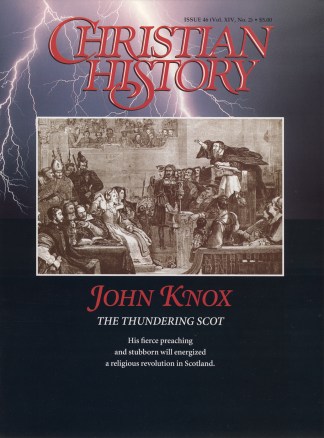In Scotland, the reformers took a radical, root-and-branch approach toward worship. They brought changes much more radical than in other reformations. Lutherans in Germany and Anglicans in England, for example, sought to retain a great deal of the medieval liturgy. Not the Scottish reformers.
They obliterated what they saw as the clutter of nonessentials in late medieval religion: making oral confession of sins, invoking Mary and the saints, venerating relics, using images, believing in purgatory, saying masses for the dead, obtaining indulgences, and making pilgrimages to shrines.
The Latin Mass was denounced as idolatrous (it appeared to involve the worship of a wafer), and blasphemous (it detracted from Christ’s unique sacrifice at Calvary). The Scottish reformers consistently called for return to, in John Knox’s words, “the grave and godly face of the primitive church.” As a result, the liturgy of the pre-Reformation church and the patterns of Protestant worship could scarcely have been more different.
Attending Mass
At the heart of the medieval Scottish liturgy was the Mass. Several ministers stood in attendance at the altar, amid rich ceremony, organ music and choristers, incense, and flickering candles offered to images.
Elaborate polyphonic music, which a professional choir alone could master, provided a suitably ornate setting for the solemn celebration and devotion of high Mass. In St. Machar’s Cathedral in Aberdeen, the enlarged choir included twenty vicars choral, two deacons, two subdeacons, two acolytes, and a master of the songschool to train the choristers.
A high sung Mass could be found daily in cathedrals, wealthy collegiate churches, and abbeys. In a great cathedral church like St. Machar’s in Aberdeen, prayers were said throughout the day. At the canonical hours of matins and lauds (before dawn), prime, terce, sext, none, vespers, and compline, clergy offered prayer, penitence, and praise on behalf of the people.
An alternative to the elaborate and lengthy high Mass was low Mass. The bulk of parish churches up and down the land were simple, often impoverished and unadorned, rural churches. There was neither choir nor music, and simpler services were conducted by a single priest and a clerk who made the responses.
In either high or low form, prevailing practice excluded the people: they were passive spectators and listeners in a rite the clergy said in Latin. Even their view of the priest’s actions at the altar was obscured because the celebrant turned eastward, his back to the congregation, until the elevation of the consecrated elements of bread and wine, the miraculous and awesome moment when the congregation might adore what they believed was the body of Christ present on the altar. Frequently, the priest was the only one to receive Communion (except on Easter, the main occasion for lay Communion).
At such masses, the people’s attendance could not be taken for granted: the provincial council of Catholic clergy meeting at Edinburgh in 1552 lamented how “very few indeed out of the most populous parishes deign to be present at the sacrifice of holy Mass on the Sundays and the other double festivals appointed by the church.”
At the same time, the belief that the sacrifice offered at each Mass removed venial sin (just as the sacrifice at Calvary did away with mortal sin) encouraged the proliferation of private masses. In Edinburgh, St. Giles’s Church had more than forty altars dedicated to Mary and the saints before which priests, silently or in low voices, said masses privately for particular souls, that they might escape torment after death. The more masses purchased, the greater the perceived benefits for the souls of the living and the dead. This emphasis transformed the corporate action of the Eucharist into individual priestly offerings.
Cleaning House
Protestant activists in Scotland embarked on a concerted campaign of iconoclasm—smashing and removing religious images, which they associated with idolatry—and of purging churches of altars, statues, crucifixes, carvings, bells, pictures, reliquaries, vestments, organs, and chalices—all the symbols they identified with Rome. They hoped to purify worship by eliminating all accretions considered to be false or detracting from the honor that God alone deserved.
For John Knox, one Mass was more fearful than ten thousand armed enemies. In 1559, his inflammatory sermon at Perth against idolatry and the “abomination of the Mass” ended in disorder and the purging of St. John’s Kirk. At the height of the struggle, abbeys and friaries were ransacked, churches despoiled, and their contents removed (though care was taken to preserve the buildings of parish churches for Protestant worship).
As the reformed congregations met for worship, out went Latin services, altars and unleavened wafers, the cult of Mary and the saints, holy days and feast days, prayers for the dead, belief in purgatory, crucifixes, elaborate ritual, eucharistic vestments, organs, and choristers, the plainsong of great churches and the silence of poor churches.
In came a simple service based on preaching, Bible study, prayers, and metrical psalms sung to common tunes. The people were no longer passive spectators but were actively encouraged to sing God’s praise as part of their worship. Seated at tables, they received both wine and bread at Communion.
This rebellion of the pious in worship was dramatic and far-reaching. By discarding the medieval liturgy, with all its visual and clerical emphases, the reformers reordered worship and focused attention on the actions of the whole congregation of believers.
James Kirk is professor in the department of Scottish history at the University of Glasgow. He is author of Patterns of Reform: Continuity and Change in the Reformation (T.&T. Clark, 1989).
Copyright © 1995 by the author or Christianity Today/Christian History magazine.Click here for reprint information on Christian History.










